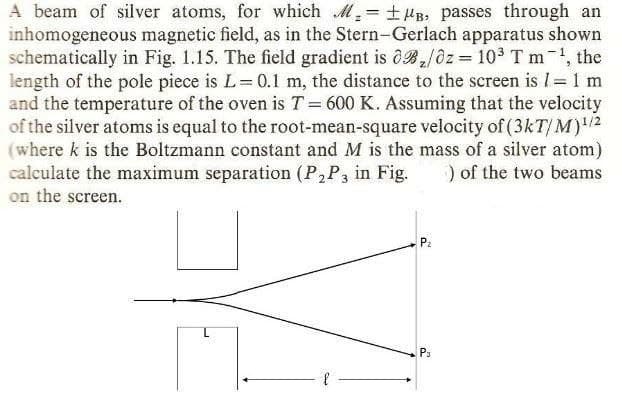A beam of silver atoms, for which M=+HB, passes through an inhomogeneous magnetic field, as in the Stern-Gerlach apparatus shown schematically in Fig. 1.15. The field gradient is 0B/0z 103 T m-, the length of the pole piece is L=0.1 m, the distance to the screen is I=1 m and the temperature of the oven is T = 600 K. Assuming that the velocity of the silver atoms is equal to the root-mean-square velocity of (3kT/M)2 (where k is the Boltzmann constant and M is the mass of a silver atom) calculate the maximum separation (P,P, in Fig. on the screen. ) of the two beams
A beam of silver atoms, for which M=+HB, passes through an inhomogeneous magnetic field, as in the Stern-Gerlach apparatus shown schematically in Fig. 1.15. The field gradient is 0B/0z 103 T m-, the length of the pole piece is L=0.1 m, the distance to the screen is I=1 m and the temperature of the oven is T = 600 K. Assuming that the velocity of the silver atoms is equal to the root-mean-square velocity of (3kT/M)2 (where k is the Boltzmann constant and M is the mass of a silver atom) calculate the maximum separation (P,P, in Fig. on the screen. ) of the two beams
Related questions
Question
I need the answer as soon as possible

Transcribed Image Text:A beam of silver atoms, for which M,= +HB. passes through an
inhomogeneous magnetic field, as in the Stern-Gerlach apparatus shown
schematically in Fig. 1.15. The field gradient is 0B/0z = 10 T m-, the
length of the pole piece is L=0.1 m, the distance to the screen is 1= 1 m
and the temperature of the oven is T= 600 K. Assuming that the velocity
of the silver atoms is equal to the root-mean-square velocity of (3kT/ M)"2
(where k is the Boltzmann constant and M is the mass of a silver atom)
calculate the maximum separation (P,P3 in Fig.
on the screen.
) of the two beams
P3
Expert Solution
This question has been solved!
Explore an expertly crafted, step-by-step solution for a thorough understanding of key concepts.
This is a popular solution!
Trending now
This is a popular solution!
Step by step
Solved in 3 steps
